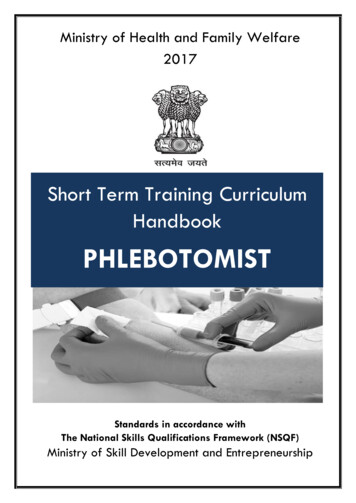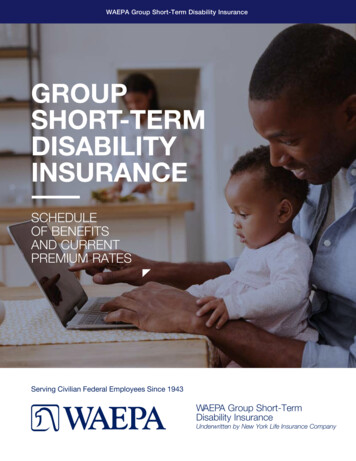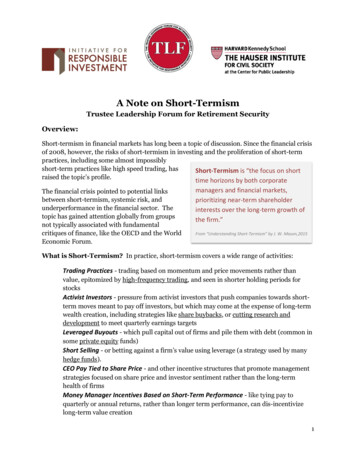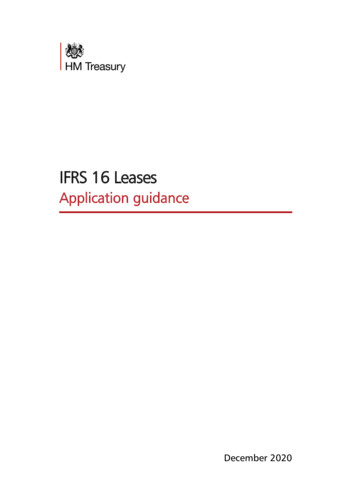
Transcription
Ministry of Health and Family Welfare2017Short Term Training CurriculumHandbookPHLEBOTOMISTStandards in accordance withThe National Skills Qualifications Framework (NSQF)Ministry of Skill Development and Entrepreneurship
Ministry of Health and Family Welfare2017Short Term Training CurriculumHandbookPHLEBOTOMISTStandards in accordance withThe National Skills Qualifications Framework (NSQF)Ministry of Skill Development and Entrepreneurship
ContentsINTRODUCTION TO THE SKILLS BASED TRAINING CURRICULA . 3Who is a Phlebotomist? . 3Scope of practice. 3Minimum Entry requirement . 4Minimum Course duration . 4Teaching faculty and infrastructure . 4Medium of instruction: . 4Attendance: . 4TRAINING CURRICULA FOR SKILL CERTIFICATION . 5MODULE – 1: FOUNDATION MODULE: INTRODUCTION TO THEPHLEBOTOMIST PROGRAM . 5MODULE – 2: FILL OUT TEST REQUISITION FORM (TRF) ACCURATELY . 9MODULE – 3: ASSEMBLE AND PREPARE NECESSARY EQUIPMENT ANDSUPPLIES . 10MODULE – 4: PREPARE AN APPROPRIATE SITE FOR OBTAINING BLOODSAMPLES. 12MODULE – 5: DRAW BLOOD SPECIMENS FROM PATIENTS USING CORRECTTECHNIQUES . 14MODULE – 6: PREPARE AND LABEL THE BLOOD SAMPLES FOR TEST,PROCEDURES AND IDENTIFICATION PURPOSES . 16MODULE – 7: TRANSPORT THE BLOOD SAMPLES TO THE LABORATORY . 17MODULE – 8: ASSIST THE PATIENT DURING AND AFTER COLLECTION OFTHE SPECIMEN . 18MODULE – 9: UPDATE PATIENT RECORDS, COLLATE AND COMMUNICATEHEALTH INFORMATION . 19MODULE – 10: FOLLOW ALL SAFETY AND INFECTION CONTROLPROCEDURES . 20MODULE – 11: ENSURE AVAILABILITY OF MEDICAL AND DIAGNOSTICSUPPLIES . 22MODULE – 12: FOLLOW BIOMEDICAL WASTE DISPOSAL PROTOCOLS . 23EQUIPMENT LIST . 25LIST OF ABBREVIATIONS . 26CONTRIBUTORS TO DRAFTING AND REVIEW OF SKILL BASED CURRICULA . 27REFERENCES: . 29Short term training Curriculum Handbook: PhlebotomistPage 1
Short term training Curriculum Handbook: PhlebotomistPage 2
INTRODUCTION TO THE SKILLS BASED TRAINING CURRICULAThe Skill based training courses are the training content developed for enhancing the specific skillsof existing professionals or provide for a platform for imparting skills to candidates with no formalqualification.To undertake the skill based training programme, it is mandatory that the candidate must fulfil theentry criteria provided for the job profile. The training and assessment will certify that thecandidate is able to undertake specific set of activities. These must not be equated with theformal qualifications- diploma/ degrees which are given by a University.It is recommended that the employer must help the candidate in continuing the studies to degreelevel and formal qualification, if the candidate is willing to gain knowledge and wants to move upthe traditional career pathway.Who is a Phlebotomist?Phlebotomy is the act of drawing or removing blood from the circulatory system through a cut(incision) or puncture in order to obtain a sample for analysis and diagnosis. Phlebotomy is alsodone as part of the patient's treatment for certain blood disorders.Phlebotomist is a health care worker who performs phlebotomy in healthcare settings. Aphlebotomist usually works in medical offices, clinics and laboratories. His/her job is toassist medical laboratory technologist/ doctors and nurses in order to exclusively take careof the blood collection process.As they deal with patients, essential qualities include an orientation to service, empathy, basiccommunication skills and the ability to follow orders and behave ethically.Scope of practiceThe objective of the program is to develop a pool of trained workforce which can be employedby diagnostic service providers to assist medical laboratory technologist/pathologist. This courseis geared to prepare personnel with 10 2 with science background and who desires to be employedas a Phlebotomist in a diagnostic care facility. This program focuses on the acquisition of skillsnecessary to draw quality blood samples from patients and prepare those specimens for medicaltesting.As per the training modules at the end of the training, the candidate would be certified to performfollowing activities–1. Demonstrate knowledge about the healthcare sector and diagnostic services2. Demonstrate the ability to perform clinical skills essential in providing basic diagnosticservices such as correctly collect, transport, receive, accept or reject and store blood/urine/stool and tissue samples, etc.; update patient records; etc.3. Practice infection control measures, Biomedical Waste Management4. Demonstrate techniques to maintain the personal hygiene needs5. Demonstrate actions in the event of medical and facility emergencies6. Demonstrate professional behaviour, personal qualities and characteristics of aPhlebotomist7. Demonstrate good communication, communicate accurately and appropriately in the roleof PhlebotomistShort term training Curriculum Handbook: PhlebotomistPage 3
8.Basics of resuscitationMinimum Entry requirementEducational requirement - The candidate must have completed 10 2 with basicunderstanding of English and Mathematics.Minimum Course durationIt is recommended that any programme developed from this curriculum should have a minimumduration of 663 hrs (148 hrs of Theory, 355 hours of Practical and 160 hours of internship)to qualify as an entry level professional in the field of Phlebotomy.Teaching faculty and infrastructureThe teaching faculty for this profession should have the following attributes: Aptitude for conducting training, and pre/ post work to ensure competent, employablecandidates at the end of the training Strong communication skills, interpersonal skills, ability to work as part of a team A passion for quality and for developing others Well-organized and focused Eager to learn and keep oneself updated with the latest in the fieldMedium of instruction:English/ regional language shall be the medium of instruction for all the subjects of study and forexamination of the course.Attendance:A candidate has to secure minimum 80% attendance in overall with at least1. 75% attendance in theoretical2. 90% in Skills training (practical) for qualifying to appear for the final examination.No relaxation, whatsoever, will be permissible to this rule under any ground including indispositionetc.Short term training Curriculum Handbook: PhlebotomistPage 4
TRAINING CURRICULA FOR SKILL CERTIFICATIONMODULE – 1: FOUNDATION MODULE: INTRODUCTION TO THEPHLEBOTOMIST PROGRAMLearning Outcomes: At the completion of this module, the student should be able to:1.2.3.4.5.6.7.8.9.10.11.12.Understand the healthcare scenario in IndiaUnderstand the duties and responsibilities of a PhlebotomistLearn the scope of work for a PhlebotomistAdhere to legislation, protocols and guidelines relevant to one’s role and field of practiceWork within organizational systems and requirements as appropriate to one’s roleRecognize the boundary of one’s role and responsibility and seek supervision whensituations are beyond one’s competence and authorityMaintain competence within one’s role and field of practiceUnderstand the art of effective communication with various stakeholders like patients,nurses, etc.Learn how to identify rapidly changing situations and adapt accordinglyHave a basic working knowledge of computersUnderstand the importance of and process of first aid and triageUnderstand his/her role in disaster preparedness and managementContent S. No.1.2.3.4.5.6.7.8.TopicsIntroduction to healthcare and hospitalsIntroduction to the Phlebotomist programProfessionalism and ValuesCommunicationInterpersonal skills and working with othersComputers and information technologyBasics of emergency care and life support skillsDisaster preparedness and 813340Total5531051015558Detail of Topics1. Introduction to healthcare and hospitalsa. Healthcare delivery system in India at primary, secondary and tertiary careb. Community participation in healthcare delivery systemc. Issues in Health Care Delivery System in Indiad. Health scenario of India- past, present and futuree. Basic medical terminology2. Introduction to the Phlebotomist programa. Role of a Phlebotomistb. Do’s and Don’tsc. Importance of Phlebotomy and need for safety protocolsd. Steps in Blood collectionShort term training Curriculum Handbook: PhlebotomistPage 5
e. Requirement to become a certified Phlebotomist3. Professionalism and Valuesa. Code of conduct, professional accountability and responsibility, misconductb. Ethics in healthcare – Privacy, confidentiality, consent, medico legal aspectsc. Understanding scope of work and avoiding scope creepd. Handling objectionse. Gather information from observation, experience and reasoningf. Identification of rapidly changing situations and adapt accordinglyg. Planning and organization of work4. Communicationa. Writing skillsi. Basic reading and writing skills, sentence formation, grammar andcomposition, how to enhance vocabularyii. Business communication like letters, e-mailsb. Special characteristics of health communicationc. How to be a good communicatori. Addressing the patientii. Body language, posture and gesturesd. Barriers of communication & how to overcome theme. Listening and Speaking skillsi. How to be a good listenerii. Structure brief and logical messagesiii. Speak clearly and slowly in a gentle toneiv. Use the correct combination of verbal and non-verbal communicationv. Use language familiar to the listenervi. Give facts and avoid opinions unless asked forvii. Communicating with patient with impaired hearing/ vision/ speech/memoryf. Recognizing changes in the patient- behaviour/ abnormal signs and reporting tothe Medical Officer/Laboratory Technologist/ Nurse in chargeg. Dealing with anger or depression of the patient5. Interpersonal skills and working with othersa. Goal setting, team building, team work, time management,b. Thinking and reasoning, problem solvingc. Need for customer service and service excellence in medical cared. Communication with various stakeholdersi. Handling effective communication with patients & familyii. Handling effective communication with peers/colleagues using medicalterminology in communicationiii. Telephone and email etiquettese. Manage work to meet requirementsi. Time managementii. Work management and prioritizationShort term training Curriculum Handbook: PhlebotomistPage 6
6. Computers and information technologya. Use of computers, its input and output devicesb. Use of basic software such as MS Office, operating systems (Windows) andinternetc. Use of data –i. Entry, saving and retrievingii. Scanning and copying medical records/documentsiii. Efficient file naming and uploadingiv. Printing, as neededd. Application of Computers in clinical settings7. Basics of emergency care and life support skillsa. Vital signsb. Basic emergency care – first aid and triagec. Identifying signs and taking measures fori. Choking and Heimlich Maneuverii. Bleeding including nosebleedsiii. Minor burnsiv. Hypothermiav. Asthma attackvi. Bites and stingsvii. Faintingviii. Spraind. Ventilations including use of bag-valve-masks (BVMs)e. One- and Two-rescuer CPRf. Using an AED (Automated external defibrillator).g. Managing an emergency including moving a patient – log transfer8. Disaster preparedness and managementa. Fundamentals of emergency managementb. Preparedness and risk reductionc. Incident command and institutional mechanismsd. Resource managementEquipment required/ teaching strategies for the above content1. Charts and demonstration dummies2. Videos and presentations3. First Aid kitShort term training Curriculum Handbook: PhlebotomistPage 7
Assessment for the above content–The candidate should be assessed on his abilities to do the following ssessment Criteria for the Assessable OutcomesExplain the role of a Phlebotomist in a hospital setting/community settingDescribe the ethical considerations of his/her job as aPhlebotomist in a hospitalWhat are the indicators for ‘Don’ts for a Phlebotomist’Describe and demonstrate how to communicate withpatient with impaired hearing/ vision/ speech/ memoryEnumerate the changes in the patient with abnormalbehaviourIdentify the various contents of First Aid KitDemonstrate Heimlich ManeuverDemonstrate the immediate action to be taken for apatient with nosebleed/ minor burns/ asthmaattack/fainting/ sprain/ hypothermia/ bites – bee sting orsnake biteExplain the importance of treating confidentialinformation correctlyDemonstrate the basic use of computers and aspectsrelated to data handlingDemonstrate basic first aid and CPRDescribe institutional mechanisms in the event of adisasterDemonstrate how to handle conflicts with patientsDescribe the functioning of major departments in ahospital.TotalShort term training Curriculum Handbook: PhlebotomistMarks AllocationViva/SkillsTotalTheory 010100202050505550560120180Page 8
MODULE – 2: FILL OUT TEST REQUISITION FORM (TRF) ACCURATELYLearning Outcomes: At the completion of this module, the student should be able to:1. Understand basic concepts behind various types of tests performed in a laboratory whichrequire drawing of blood2. Learn the importance of details relating to Test Requisition Forms(TRU)3. Understand how to fill out and interpret Test Requisition FormsContent S.TopicsNo.1.Basic Principles of tests performed in healthcare settingwhich require collection of blood samples2.Test Requisition Forms and 040Detail of Topics1. Basic Principles of tests performed in healthcare settings which require collectionof blood samplesa. Anatomical and physiological significanceb. Relevance and use according to local area needs and disease profile2. Test Requisition Forms (TRF)a. Types of TRFb. Significance of recording details on Laboratory TRFc. Important aspects of the TRFd. Filling accurate information in the right location in the TRFe. Interpreting the TRF detailsEquipment required/ teaching strategies for the above contentCharts, audio video demonstration, sample TRFsAssessment for the above contentThe candidate should be assessed on his abilities to do the following activities:S.No.1.2.3.TopicsExplain the basic principles behind tests performed inlaboratory which require drawing of bloodDemonstrate filling out a sample Test Requisition FormDemonstrate interpreting a filled out sample Test RequisitionFormTOTALShort term training Curriculum Handbook: PhlebotomistMarks AllocationViva/SkillsTotalTheory Practical20204010107070808030170200Page 9
MODULE – 3: ASSEMBLE AND PREPARE NECESSARY EQUIPMENT ANDSUPPLIESLearning Outcomes: At the completion of this module, the student should be able to:1. Identify various equipment used for venipuncture2. Utilize sterilization techniques for equipment3. Understand and implement inventory management practices for supplies and equipmentContent S.TopicsNo.1.Blood Collection systemTheory2HoursPractical3Total52.Equipment used in venipuncture37103.Inventory management of supplies and equipment281071825TOTALDetail of Topics1. Blood collection systems –a. Openb. Closedi. Vacuum extraction systemsc. Advantages and disadvantages2. Equipment used in venipuncturea. Identification, types and usage of equipment used for venipuncture such as i. Tourniquetii. Glovesiii. Antiseptic and disinfectantiv. Needle Needle size Selection of needle based on size, location and volume of blood tobe collectedv. Syringe or needle holder Size of syringes Selection of syringe based on patient, volume of blood to becollected, strength of vacuum expectedvi. Specimen containervii. Gauze – choice of gaugeviii. Tape for strappingix. Sharps disposal container and safety devicesb. Sterilization and sanitizationc. Troubleshooting and maintenance3. Inventory management of suppliesShort term training Curriculum Handbook: PhlebotomistPage 10
Equipment required/ teaching strategies for the above content- A list of equipment isavailable at Annex.Assessment for the above contentThe candidate should be assessed on his abilities to do the following activities:S.No.1.2.3.4.5.TopicsEnumerate the difference between open and close system ofblood collectionIdentify and select appropriate equipment including needle,collection system and blood collection tubes for routine tests.Describe the types of needles, syringes and their criteria forselectionExplain and Demonstrate sterilization and sanitizationtechniques for equipmentExplain inventory management practices for supplies andequipmentTOTALShort term training Curriculum Handbook: PhlebotomistMarks AllocationViva/SkillsTotalTheory Practical55100303010405010102020204045105150Page 11
MODULE – 4: PREPARE AN APPROPRIATE SITE FOR OBTAINING BLOODSAMPLESLearning Outcomes: At the completion of this module, the student should be able to:1. Understand basic concepts behind selection of various sites for drawing blood sample2. Prepare the patient3. Identify and select an appropriate site for venipunctureContent S.No.1.2.3.TopicsBasic Anatomy and Physiology: Heart and BloodPatient preparationPrinciples of site selection and process for 552530124355Detail of Topics1. Basic Anatomy and Physiology: Heart and Blooda. Circulatory systemb. Lymphatic systemc. Respiratory systemd. Urinary systeme. Muscular and Skeletal systemf. Composition of blood and blood cells2. Patient preparationa. Proper patient identification procedures and protocols to follow for different agegroup of patientsb. Patient interaction and reassurancec. Patient preparationi. Handling patient in special conditionsii. Patient positioningiii. Cleaning the venepuncture sited. Factors affecting patient preparationi. Therapeutic drug monitoringii. Effects of exerciseiii. Stressiv. Diurnal rhythmv. Posturevi. Age, gender, pregnancy etc.3. Principles of site selection and process for drawing blood Proper site selection forvenepuncturea. Proper site selectioni. For general patientsii. For hospitalized patientsiii. For paediatric patientsb. Following standard precautionsShort term training Curriculum Handbook: PhlebotomistPage 12
c. Site selectioni. Attributes of preferred veinii. Vein selectioniii. Palpating the veiniv. Inappropriate sites for venepunctureEquipment required/ teaching strategies for the above contentCharts, audio video demonstration, equipment used in phlebotomy (List of equipment at Annex)Assessment for the above contentThe candidate should be assessed on his abilities to do the following activities:S.No.1.2.3.TopicsExplain the basic principles of Anatomy and Physiologyincluding various systems in human bodyDemonstrate the steps for patient preparationExplain and demonstrate site selection procedures forvenipunctureTOTALShort term training Curriculum Handbook: PhlebotomistMarks AllocationViva/SkillsTotalTheory Practical101020520251070802080100Page 13
MODULE – 5: DRAW BLOOD SPECIMENS FROM PATIENTS USING CORRECTTECHNIQUESLearning Outcomes: At the completion of this module, the student should be able to:1. Accurately angle the insertion and perform a successful insertion of needle2. Demonstrate correct order of draw necessary for drawing blood using correct techniqueContent S.TopicsNo.1.Needle insertion techniqueTheory5HoursPractical20Total252.Order of draw520253.Tube filling55104.Needle removal and sharp disposal55105.Prophylactic treatment in case of emergencies duringdrawing bloodTOTAL2810225880Detail of Topics1. Needle insertion techniquea. Angle of insertionb. Insertion techniquec. Areas of caution2. Order of drawa. Importance of correct filling order of sample tubes (Order of draw)b. First drawc. Second drawd. Third drawe. Last draw3. Tube filling4. Needle removal and sharp disposal5. Prophylactic treatment in case of emergencies during drawing blood6. Special casesa. Arterial blood samplingb. Paediatric and neonatal blood samplingc. Capillary sampling7. Collecting blood in various case situations:a. Shockb. Haemorrhagec. Road Traffic Accidentsd. Neonatese. Infants, etc.Short term training Curriculum Handbook: PhlebotomistPage 14
Equipment required/ teaching strategies for the above content1. Venepuncture equipment2. Arterial Sampler3. Lancets and Micro-collection equipmentAssessment for the above contentThe candidate should be assessed on his abilities to do the following activities:S.No.Topics1.Explain and demonstrate the procedure for needle insertion2.Explain and demonstrate correct order of drawTOTALShort term training Curriculum Handbook: PhlebotomistMarks AllocationViva/SkillsTotalTheory Practical1040501040502080100Page 15
MODULE – 6: PREPARE AND LABEL THE BLOOD SAMPLES FOR TEST,PROCEDURES AND IDENTIFICATION PURPOSESLearning Outcomes: At the completion of this module, the student should be able to:1. Prepare blood samples for test, procedures and identification purposes2. Correctly identify and label samples for test, procedures and identification purposesContent S.TopicsNo.1.Post venepuncture processTheory2HoursPractical3Total52.Preparation of blood samples515203.Labeling of blood samples281092635TOTALDetail of Topics1. Post venepuncture processa. Examination of venipuncture siteb. Application of adhesive bandagec. Instructions to patient2. Preparation of blood samplesa. Coagulationb. Mixing of samplesi. Importance of mixing samplesii. Process of mixing samples3. Labelling of blood samplesa. Identification of samplesb. Precautions for labelling specimenc. Bar code labelling4. Types of sampling for various tests:a. Whole bloodb. With coagulantc. Shaking of samplesd. Without shaking of samples5. Time duration of patient preparation before sampling6. Blood Glucose sampling7. Instructions for FB and PP testsEquipment required/ teaching strategies for the above content-Charts, audio video demonstration, equipment used in phlebotomy (List of equipment at Annex)Assessment for the above contentThe candidate should be assessed on his abilities to do the following activities:S.No.1.2.TopicsExplain and demonstrate blood sample preparationDemonstrate correct labelling of blood samplesTOTALShort term training Curriculum Handbook: PhlebotomistMarks AllocationViva/SkillsTotalTheory Practical1040501040502080100Page 16
MODULE – 7: TRANSPORT THE BLOOD SAMPLES TO THE LABORATORYLearning Outcomes: At the completion of this module, the student should be able to:1. Pack blood samples correctly for transportation2. Ensure maintenance of appropriate temperature conditions of transportation of bloodsamples3. Ensure transportation of blood samples to laboratory without any damageContent S.No.TopicsTheoryHoursPracticalTotal1.Process of transporting sample28102.3.Conditions necessary for transportation of samplesPacking of samplesFactors that influence the outcome of laboratory resultsduring collection and transportationTOTAL223355235817254.Detail of Topics1. Process of transporting sample2. Conditions necessary for transportation of samplesa. Temperatureb. Pressure, and other necessary conditions3. Packing of samplesa. Ideal conditions of packing of blood samples4. Factors that influence the outcome of laboratory results during collection andtransportation:a. Knowledge of staff involved in blood collectionb. Use of the correct gauge of hypodermic needle to prevent haemolysis or abnormalresultsc. The anatomical insertion site for venipunctured. The use of recommended laboratory collection tubese. Patient–sample matching (i.e. Labelling)f. Transportation conditionsg. Interpretation of results for clinical managementEquipment required/ teaching strategies for the above contentCharts, audio video demonstration, equipment used in phlebotomy (List of equipment at Annex)Assessment for the above contentThe candidate should be assessed on his abilities to do the following activities:S.No.1.2.3.TopicsExplain and demonstrate blood sample packingExplain conditions necessary for transportation of samplesExplain conditions necessary for transportation of samplesTOTALShort term training Curriculum Handbook: PhlebotomistMarks AllocationViva/SkillsTotalTheory Practical2020402020402020406060120Page 17
MODULE – 8: ASSIST THE PATIENT DURING AND AFTER COLLECTION OFTHE SPECIMENLearning Outcomes: At the completion of this module, the student should be able to:1. Identify the complications during the specimen collection2. Identify causes of failed venipuncture and take corrective actions3. Identify potential patient-related complications arising from venipuncture4. Manage adverse events and administer relevant post-prophylactic treatmentsContent S.No.1.2.TopicsCauses of failed venipunctureAdverse events and post exposure 717Detail of Topics1. Causes of failed venipuncturea. Procedure related such as i. Improper positioning of tubeii. Rolling of veinsiii. Puncture through veinsiv. Collapsed veinv. Partially inserted needlevi. Accidental arterial punctureb. Patient relatedi. Excessive bleedingii. Petechiaeiii. Nauseaiv. Vomitingv. Faintingvi. Seizuresc. Corrective measures for failed venipuncture2. Adverse events and post exposure prophylaxisa. First aidb. Management and follow upEquipment required/ teaching strategies for the above content- Charts, audio videodemonstration, equipment used in phlebotomy (List of equipment at Annex)Assessment- The candidate should be assessed on his abilities to do the following activities:Marks AllocationS.Viva/SkillsTopicsNo.TotalTheory PracticalExplain and demonstrate preparation of patient before,2020401.during and after collection of specimenExplain factors affection preparation of verseevents2020403.TOTAL6060120Short term training Curriculum Handbook: PhlebotomistPage 18
MODULE – 9: UPDATE PATIENT RECORDS, COLLATE AND COMMUNICATEHEALTH INFORMATIONLearning Outcomes: At the completion of this module, the student should be able to:1. Explain the importance of patient record database management and documentation2. Demonstrate maintenance of patient records with respect to specimen details3. Explain basic concept of Electronic Health Records (EHR) and Electronic MedicalRecords (EMR)4. Collect relevant health information from the patient5. Communicate effectively to the patient while exchanging health information6. Put the patient at ease while collecting medical historyContent –S.TopicsNo.1.Patient record database management and nic Health Records and Electronic Medical Records28103.Sources and types of health information25761824TOTALDetail of Topics1. Patient record database management and documentationa. Medical recordsb. Databasec. Documentation and Database Management2. EHR and EMRa. Electronic Health Recordsb. Electronic Medical Records3. Sources and types of health informationa. Primary, secondary and tertiary sources of health informationb. Evidence based health information sourcesi. Health literacyii. Patient values and preferencesEquipment required/ teaching strategies for the above content- Charts, audio videodemonstration, equipment used in phlebotomy (List of equipment at Annex)Assessment The candidate should be assessed on his abilities to do the following activities:S.No.Topics1.2.Explain the importance of documentation of patient recordsExplain Electronic Health and Medical RecordsDemonstrate maintenance of patient database from dummydataExplain the importance of collecting relevant healthinformationExplain sources and types of he
Phlebotomy is the act of drawing or removing blood from the circulatory system through a cut (incision) or puncture in order to obtain a sample for analysis and diagnosis. Phlebotomy is also done as part of the patient's treatment for certain blood disorders. Phlebotomist is a health care worker who performs phlebotomy in healthcare settings. A











